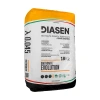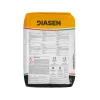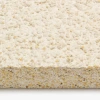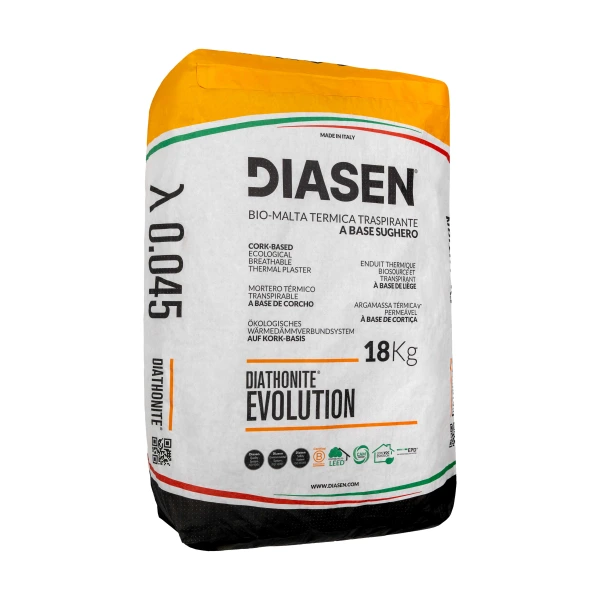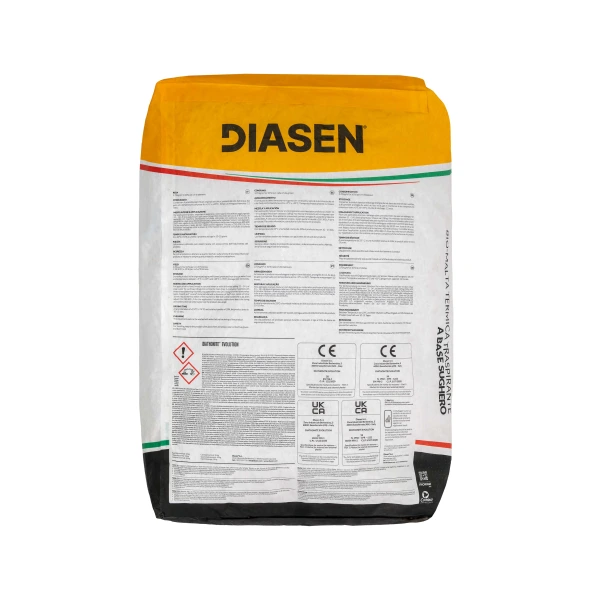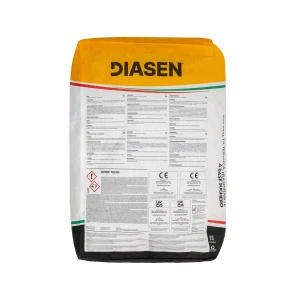Diasen Diathonite Evolution
Product Overview
Main purpose
Insulating the building and maintaining the breathability of the wall/ceiling.
Use it on
Internal or external solid stone or masonry walls and ceilings. Can also be applied to wood-based panels/sheathing and plasterboard that have been primed with Diasen Aquabond Primer.
Overview
Diathonite Evolution is a fully breathable lime-based insulating plaster made from Hydrated lime, NHL 3.5 binder, Clay, Cork and Diatomaceous earth. It is highly breathable and helps walls in older buildings dry out thanks to its capillary active nature. Diathonite Evolution thermal plaster can be used internally or externally on solid stone or masonry walls and ceilings. It should be applied to exposed stone or brick after any gypsum plaster has been removed. It can also be applied on wood-based panels, lath and plasterboard that have been primed with Diasen Aquabond.
Where to use it
Diathonite Evolution thermal plaster can be used internally or externally and is ideally suited for the restoration and insulation of Historic/Listed buildings or any building with solid stone or masonry walls.
Before you start your project, it is essential to investigate and fix any existing damp or moisture related issues in the wall; please see our installation guide for full details.
For optimal performance and longevity of any internal wall insulation system, it is crucial to evaluate the suitability of the wall and rectify any problems before installation begins. Please read our guide: “How to prepare traditional solid walls for IWI Installation” to ensure you achieve the best results.
What it does
Diathonite Evolution is an insulating plaster that can help regulate moisture to manage damp and humidity in solid walls often found within older buildings. Please note, Diathonite Evolution does not cure penetrating damp. Prior to application, any existing damp problems must be fully resolved.
In a typical installation, applying 50 - 75mm of Diathonite Evolution will improve the thermal performance of the wall by 3.5-4.5 times. This thickness is the most cost-effective way to provide a significant thermal improvement to the wall.
The mechanical strength and elasticity are provided by the clever combination of natural ingredients. Elasticity reduces the risk of micro-cracking for a long-lasting durable finish.
Diathonite Evolution is supplied in 18 kg bags. There are 60 bags per pallet.
How it works
The Diathonite system is breathable and capillary active. It lets vapour pass through and actively transports moisture from the structure of the building helping the wall and building dry out. It regulates humidity and prevents condensation and mould growth.
Why we love it
The main ingredients are Hydrated lime, NHL 3.5 binder, Clay, Cork and Diatomaceous earth. These all-natural ingredients are sympathetic to the conservation requirements of listed buildings and will contribute to LEED credits.
Evolution dries much faster than a traditional lime plaster; usually it only takes one third of the time which works out at approximately 2mm per day.
Unlike dry board systems, Diathonite Evolution is malleable and flexible when being applied. This gives many beautiful aesthetic options for rounded window reveals and curved wall surfaces that follow the contours of the underlying stone or brick, especially in stone cottage refurbishments. A more modern style finish can also be achieved when required.
Diathonite Evolution is not only a highly effective stand-alone insulating system but also an ideal levelling coat for uneven walls prior to using breathable insulating board systems like Gutex Thermoroom and Calsitherm.
It is non-combustible so will not burn or emit smoke.
Features
- Excellent thermal conductivity
- All-natural ingredients
- Beautiful finish
- Safe and eco-friendly
- Breathable and Capillary active
- Easy Application
- High Elasticity
- Easy thermal bridge solution
- Excellent drying times
- Fire Protection
- Antibacterial Properties
Benefits
- 50mm of Evolution improves the thermal performance of a wall by approximately 3.5 times.
- Dual function plaster; can be used to level walls and to insulate.
- Natural cork and lime provide breathability, thermal insulation and elasticity while also maintaining the unique characteristics of the wall.
- Can be used internally and externally allowing walls to breathe and balance room humidity.
- Up to 10 times more elastic than traditional plasters reducing the risk of cracks.
- Provides a simple and easy solution to eliminate thermal bridges.
- Can be sprayed-on or applied by hand. An experienced lime plasterer or DIY enthusiasts can install it with no special training.
- Dries much faster than traditional lime.
- Euroclass A1 fire resistance, does not burn or emit smoke so improves fire safety of buildings.
- Alkalinity of lime prevents the formation of mould and condensation.
- Complies with Building Regulations.
Questions
Do you need to pre-prime bare brickwork or blockwork prior to applying the Diathonite range of plasters?
Typically, Diathonite plasters (Diathonite Thermactive and Diathonite Evolution) can be applied onto bare blockwork, brickwork or stone with no primer. A fine mist of moisture can sometimes assist with the initial key of Diathonite plasters onto the wall. For low-moisture absorptive surfaces such as timber, existing smooth lime plaster etc., then Diasen Aquabond primer must be applied.
Are hydrophobic creams breathable? Do they prevent moisture from escaping from inside to outside?
Hydrophobic creams such as Diasen BKK Eco are water repellent and moisture vapour diffusion open. This has been tested for moisture vapour diffusion openness in accordance with EN7783. This means that the external face of the wall is protected from wind driven rain but any moisture inside the wall can harmlessly diffuse out of the building.
“Diathonite plasters are the best performing thermal plasters, but are very expensive!”
When compared with other thermal plasters, the overall applied cost of Diathonite Thermactive and Diathonite Evolution is extremely competitive. This is because each has an exceptionally low thermal conductivity, meaning less material is required to reach a specific U-value. Thermactive and Evolution also have excellent coverage rates of 2.6kg/m2 and 3.7kg/m2 per 10mm thickness (+/- 10% based on machine application on a level smooth wall). Drying times are quicker too: as a rule of thumb Diathonite plasters dry at a rate of 2mm per day compared with 1mm per day for conventional lime plaster. This speed of application results in a faster project turnaround and can produce significant savings.
Technical Details
Key Technical Data
Installation Guide
Find an installerBefore You Start
Before installing any internal wall insulation, it is essential to investigate and fix any existing damp or moisture related issues in the wall. Even though our internal wall systems are breathable and provide optimal protection against condensation, persistent damp issues must be resolved first. A wet wall is a cold wall, so preparation to remove or reduce external sources of moisture is key to achieving optimum results.
Once damp issues have been resolved, the wall should be allowed to dry thoroughly and re-assessed for suitability of internal wall insulation.
Any existing gypsum plaster on the internal side of the wall should be removed first to reveal the stone or masonry underneath. This ensures the wall will be fully breathable and allows the Diathonite to work to its full potential. It also provides a reliable key for maximum adhesion of the Diathonite to the wall.
These are the main considerations before commencing any work:
- Is there evidence of moisture in the walls?
- Is there any evidence of condensation, fungus or mould growth on the internal walls?
- Is there a functioning damp proof course (DPC)?
- Is there sufficient ventilation in the property?
- Is the external ground level higher than the floor level inside?
- Are there any structural defects in the external walls?
- Is guttering, flashings and external pipework in good condition?
- Is the external render, pointing or cladding in good condition and providing adequate weather protection?
- Is the external finish suitable for the severity of wind driven rain exposure?
- Are the timber joists embedded in external walls free from infestation and rot?
- Has the building ever been flooded?
- If you chose not to remove existing plaster on the wall, is this plaster fully compatible with the insulation system being used? (Ideally, it would need to be lime-based, any existing gypsum plaster on the internal side of the wall should be removed first)
How to Install
The minimum application thickness of Diathonite plaster is 15mm. It should be built up in 15-25mm layers to the required total thickness, generally one layer of Diathonite per day. A typical thickness of 40-60mm improves the thermal performance of the wall by 3.5-4.5 times.
For thicknesses of 60mm or more, Diasen Polites 140 reinforcing mesh must always be used. This should be applied when half the total thickness of Diathonite has been applied (and it is still wet). So, for 70mm total thickness, you must apply 35mm of Diathonite, then Polites Mesh, then the remaining 35mm.
For application on a ceiling, the maximum thickness is 30mm. This should be applied in two 15mm layers with reinforcing mesh in between. Reinforcing mesh must always be used when applying Diathonite to a ceiling.
When used internally: Diathonite Evolution should be finished with a layer of Argatherm, a breathable lime-based finishing plaster and breathable paint like Auro. If the external face of the wall is not rendered and only the inside was insulated, we would recommend a breathable rain repellent like BKK Eco to be used externally to limit the amount of moisture absorbed by the wall externally.
When used externally: Diathonite Evolution may be finished with Argatherm followed by a breathable primer and paint.
For projects over 100 square meters, your installer may apply Diathonite Evolution using a spray pump machine. This is quicker than hand applying and uses approximately 10-15% less material because the plaster is not being compacted by a trowel. An experienced trained installer is always recommended for larger projects.
Please view the training videos below as guidance. These actually demonstrate installation of Diathonite Thermactive .037, but the methods shown will also apply to Diathonite Evolution.



Hints and Tips
All coverage/yield figures quoted are based on application to a smooth level surface. They are for guidance only and do not include material required to level (dub out) the walls.
Fixing items to Diathonite plasters
Diathonite thermal plasters are non-structural mortars. This means to fix items to walls, they must be fixed through the Diathonite directly into the masonry.
Similar to most plasters, Diasen thermal plasters should not be relied upon as a means of fixing heavy items such as shelving, cabinets, sanitaryware etc. Lightweight items such as sockets, light switches etc. can be fixed using suitable wall plugs or dowels.
Example fixings for support of lightweight items secured into insulation (rather than masonry) can be seen in this PDF on pages 16-18. Always follow the fixing supplier's guidance precisely if the fixings described in this PDF are used.
Tiles may be applied to Diathonite thermal plasters following the tile adhesive's application instructions. A thickness of 30mm of Diathonite can support, up to 50kg of tiles per m². This is only possible if the bottom row of tiles rests on the floor in order to bear some of the weight.
Problematic walls
On walls with white salt deposits (efflorescence) or high moisture content, Diathonite Deumix+ can be used to speed up drying and act as a salt inhibitor. Diasen Regularisation could also be used as the first layer of plaster (underneath the Diathonite Evolution) on walls with severe salt issues when required.
Tiling
If you wish to use ceramic tiles on top of Diathonite thermal plaster, both the Diathonite and the finish plaster must be reinforced with mesh. Use Diasen Polites 140 mesh for the Diathonite and Polites 80 mesh for the Argatherm finishing plaster. Refer to each product’s installation guide for mesh application details.
Additionally, if the wall is in a bathroom (or wet room) in an enclosed shower/bath area, a waterproof tanking plaster such as Diasen Watstop must be applied over the Argatherm finishing plaster wherever the tiling will be applied. Please refer to the Watstop installation guide for the correct method of application. Tiles must be applied to Watstop within 48 hours of it being applied.
Note, the weight of tiles per square metre must not exceed 45 kg for this specification.


